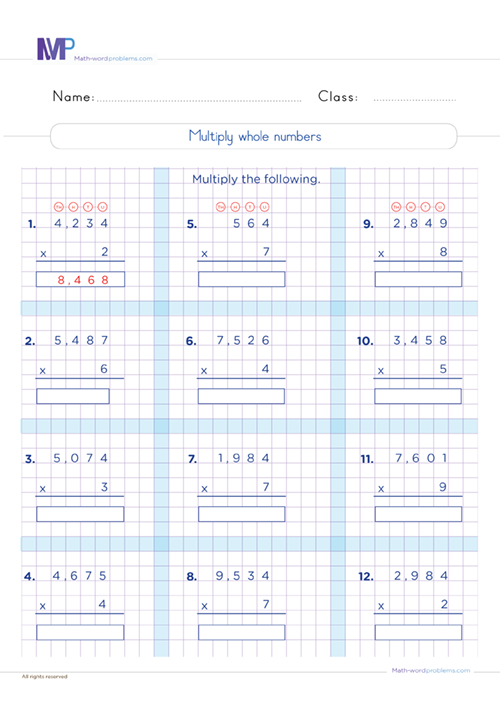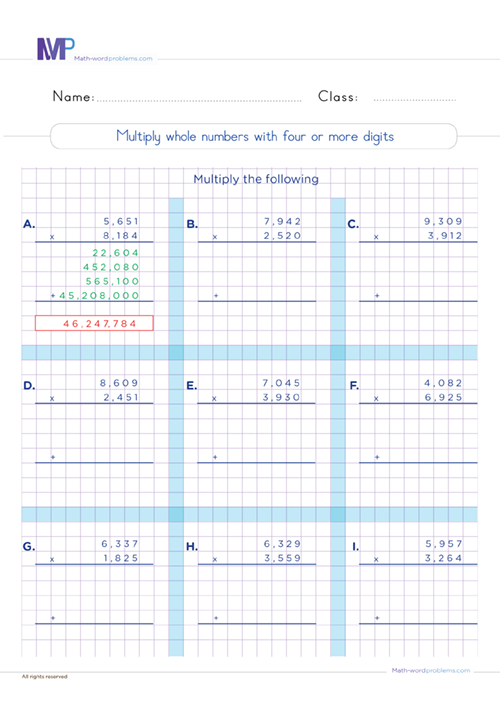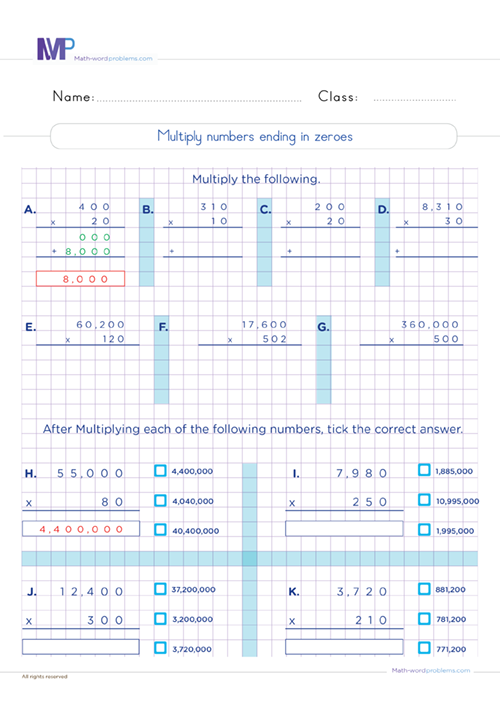 How to perform multiplication of whole numbers word problems
How to perform multiplication of whole numbers word problems

- INTRODUCTION
- Step1 Identify
- Step 2 STRATEGIZE
- Step 3 SET UP
- Step 4 PROVIDE A SOLUTION
- Step 5 CHECK YOUR WORK
Get more contents on this skill...
Find here a perfect guide on how to perform multiplication of whole numbers word problems with a step-by-step procedural guide below. Believe it or not, this procedure consists of simple tips and techniques that your kids will need to enhance their word problems solving skills.
After grasping our powerful and straightforward way of solving word problems, your kids will eventually show their potential in multiplying whole numbers word problems of all kinds.
Steps to solve multiplication of whole numbers word problems
Your kids will enjoy and use the following steps to solve multiplication of whole numbers word problems quickly and efficiently.
After going through these steps, you'll be amazed at how your kids have become proficient math word problem solvers.
To fully engage sixth graders in these steps, we will include outstanding real-life examples to show how these steps work.
Step 1: IDENTIFY:
Here is where you have to showcase your reading comprehension skills. That is to say; you must read the whole problem carefully and identify important numbers and keywords in the word problem.
For instance, whenever you come across one of the following keywords in a word problem: - times, multiplied by, product, product of, factor, of, multiply, times, multiple, double, triple, groups, by, twice, area, equal groups, every, in all, total, increased by, as much, each, lots of, groups of, per, etc., then it implies that you have to perform a Multiplication Operation.
***One key Element for learners to understand is that they should not always rely on keywords alone. That is to say; the same keyword can have different meanings in different word problems.
For this reason, we reiterate on the importance of reading the question very carefully to understand the situation that the word problem is describing, then figure out exactly which operation to use***
Step 2: STRATEGIZE:
Think about how you will solve or go about solving the word problem.
- Thus, from the keyword(s) in the word problem, you will know if you need to perform a Multiplication Operation or Not.
- It would be best not to only depend on keywords. Rather, try to understand the situation that the problem is describing.
- Additionally, after knowing which operation you will perform, construct short expressions/sentences to represent the given word problem.
Step 3: SET UP:
Then, write down a numerical expression representing the information in the word problem.
Step 4: PROVIDE A SOLUTION:
From step 3 above, multiply the numbers using regrouping or other multiplication methods like long multiplication, grid multiplication, or lattice method to determine the result. Do not forget the sign, if any.
Step 5: CHECK YOUR WORK:
FLastly, ask yourself this question. "Does my answer make sense?" If "YES," you are done. If "NO," go back to step 1 and start again.
Examples on how to perform multiplication of whole numbers word problems
Example one:
During Halloween, a candy store sold 92,563 candies. If each candy cost $5, how much money did the store make in all?
Step 1:The important numbers here are 92,563 and $5. Additionally, the keyword(s) found in the word problem is "in all" and "each."
Step 2:Next, how will you solve the problem? Looking at the problem's description and the keyword(s) found in the word problem calls for you to perform a multiplication operation.
Also, after knowing which operation you will perform, construct short expressions/sentences to represent the given word problem.
- Total Number of candies the store sold = 92,563.
- Cost of each candy = $5.
- Therefore, the amount of money the store made in all = the number of candies the store sold × the cost of each candy.
Step 3:Now, write down a numerical expression to represent the bolded sentence in step 2 above:
92,563 × $5 = ?
Step 4: Then, multiply the numbers using regrouping or any other multiplication methods like long multiplication, grid multiplication, and lattice to determine the result. Moreover, always recall the unit of measurement, if any.
Using the long multiplication method, we have
So, the store made $462,815 in all.
Step 5: In conclusion, check out your work to know if it makes sense, i.e., by estimating the numbers and calculating mentally. If the answer is so close to the one you have, then your answer is correct but if the answer is not close to your answer, go back to step 1.
Example two
Step 1: First, read the word problem very well and then pick out the important number, which is 78,526.
As you read further, you'll see a year being mentioned. Your brain should be thinking about how many days there are in a year.
Now, as you continue reading, the keyword(s) that you'll come across in the word problem is "in all" and "each."
Step 2: Next, how will you solve the problem? Looking at the problem's description and the keyword(s) found in the word problem implies that you should perform a multiplication operation.
Also, after knowing which operation you will perform, Construct short expressions/sentences to represent the given word problem.
- Number of words she types each day = 78,526.
- Number of days in a year = 365.
- Therefore, the Number of words she could have typed in a year = the Number of words she types each day × the Number of days in a year.
Step 3:Now, write down a numerical expression to represent the bolded sentence in step 2 above:
78,526 × 365 = ?
Step 4: Then, multiply the numbers using regrouping or any other multiplication methods like long multiplication, grid multiplication, and lattice method to determine the result. Moreover, always recall the unit of measurement, if any.
Using the long multiplication method, we have
So, she typed 28,661,990 words in January.
Step 5: in conclusion, check out your work to know if it makes sense, i.e., by estimating the numbers and calculating mentally. If the answer is so close to the one you have, then your answer is correct but if the answer is not close to your answer, go back to step 1.





